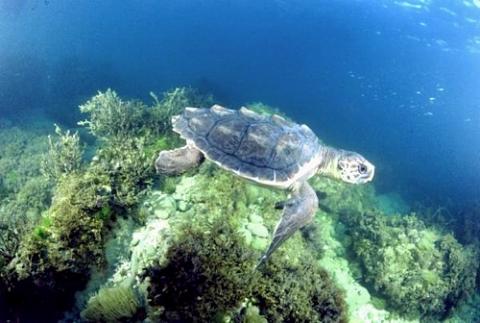Loggerhead sea turtles, one of several turtle species that have come ashore to nest from Cape Hatteras National Seashore south to Gulf Islands National Seashore, are not doing well, population-wise. The species currently is being proposed for listed as "endangered" under the Endangered Species Act.
Last week the National Marine Fisheries Service and Fish and Wildlife Service announced a proposal to change the status of both the U.S. North Pacific and Northwest Atlantic loggerhead sea turtles from "threatened" to "endangered." The government also proposed listing loggerhead sea turtles around the globe as nine separate populations, each with its own threatened or endangered status.
Public comment is being taken on this proposal through June 14.
“The proposed rule marks a turning point in our ability to protect loggerhead sea turtles,” said Andrea Treece, an attorney with the Center for Biological Diversity. “By recognizing and preventing impacts to regional populations and their habitats, we’ll have a much better chance of putting these magnificent, prehistoric animals on a path to recovery instead of extinction.”
Loggerhead turtles, which have come ashore at Cape Hatteras, Cape Lookout, and Gulf Islands national seashores, as well as Biscayne, Everglades, and Dry Tortugas national parks, were listed as "threatened" back in 1978, according to Fish and Wildlife Service records. The decision by the two agencies to change the listing to "endangered" came only after they were sued for failing to act on a petition seeking a determination on the species' status. The determination was sought by the Center for Biological Diversity, Oceana, and the Turtle Island Restoration Network.
While critical habitat is not currently designated for loggerheads, the change in listing status means the populations are in danger of extinction and will trigger a legal requirement for proposed critical habitat, step in achieving improved protections for key nesting beaches and migratory and feeding habitat in the ocean, the Center for Biological Diversity said in a release.
“Loggerhead sea turtles will struggle to survive if we don’t protect the areas where they nest, swim, and eat,” said Dave Allison, senior campaign director at Oceana. “It’s time for the U.S. government to stop delaying and actually establish protections that will once and for all allow this endangered species to recover.”
The folks at Canaveral National Seashore long have been working to bolster loggerhead populations. Each year they record up to 4,500 loggerhead nests along its 24 miles of beach, and park biologists have developed a monitoring and nest protection program utilizing seasonal employees teamed with more than 60 volunteers to record and place protective screens over the nests to deter predators. More than 95 percent of the nests are protected each year.
Yet one location can't save the species. The scientific basis for the uplisting proposal is a 2009 status review (attached below) of loggerhead sea turtles worldwide by the Fisheries Service. It identified nine discrete population segments and found both North Pacific and Northwest Atlantic loggerheads “currently at risk of extinction.”
“Loggerheads will disappear from the Pacific without greater protections from capture in fisheries,” said Todd Steiner, executive director of Turtle Island Restoration Network. “Action is more urgent than ever with the recent expansion of the Hawaiian swordfish fleet and the tripling of loggerhead capture.”
Loggerheads have declined by at least 80 percent in the North Pacific and could become functionally or ecologically extinct by the mid-21st century if additional protections are not put into place. Florida beaches, which host the largest nesting population of loggerheads in the Northwest Atlantic, have seen a decline in nesting of more than 40 percent in the past decade, according to the organizations.
Human actions, including commercial fishing and habitat degradation, are pushing loggerheads toward extinction, they added, noting also that climate change threatens to make the situation even worse.
In addition to demanding that the Fisheries Service protect sea turtles and their habitat under existing law, the groups are calling for comprehensive legislation that would protect U.S. sea turtles in ocean waters as well as on land.




Comments
Just want to note that in addition to the parks and seashores you listed in your article, Cumberland Island National Seashore and Canaveral National Seashore are also important nesting sites for Loggerheads.
It's about time our loggerhead turtles are being recognized as an endangered species.